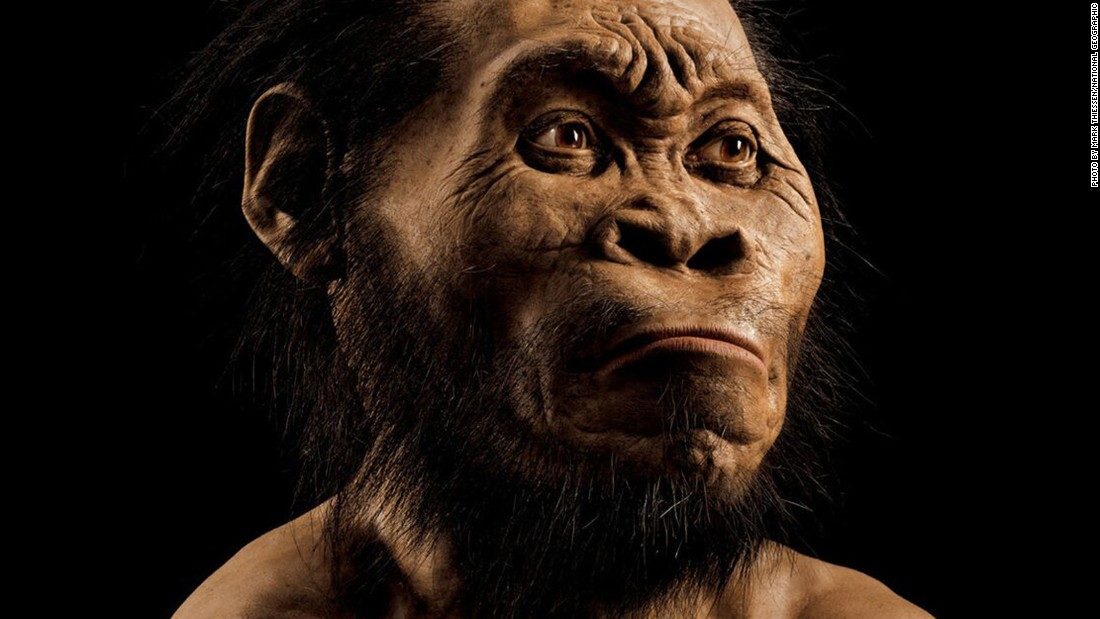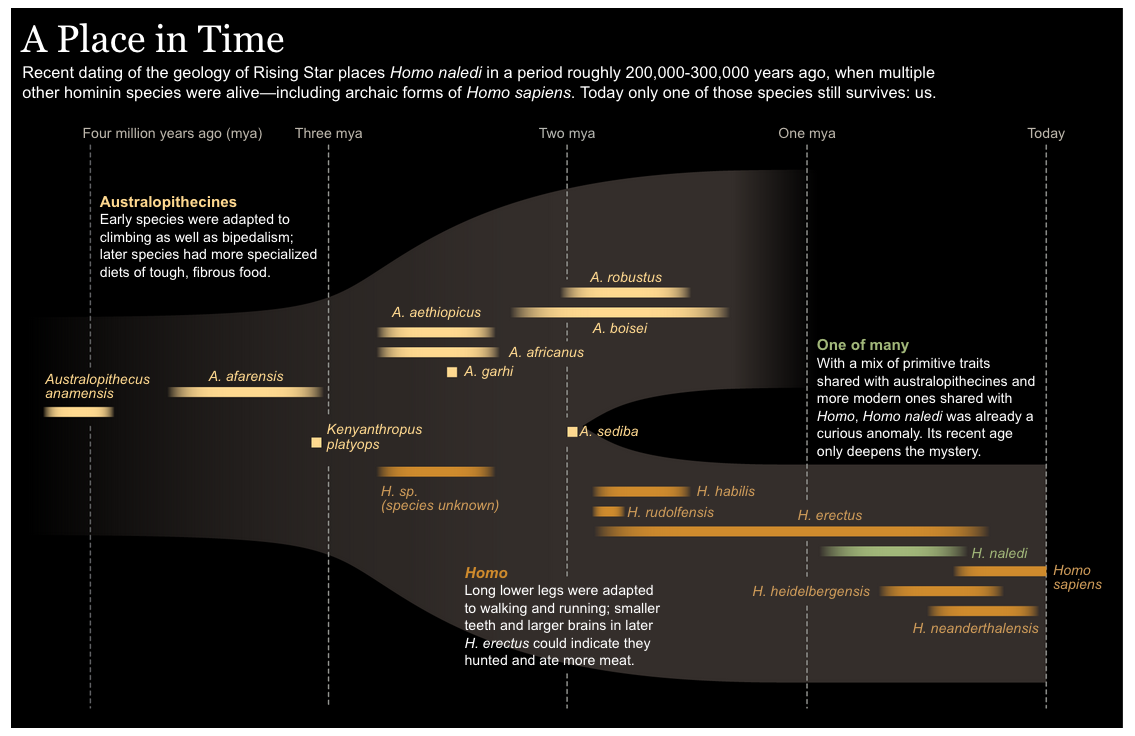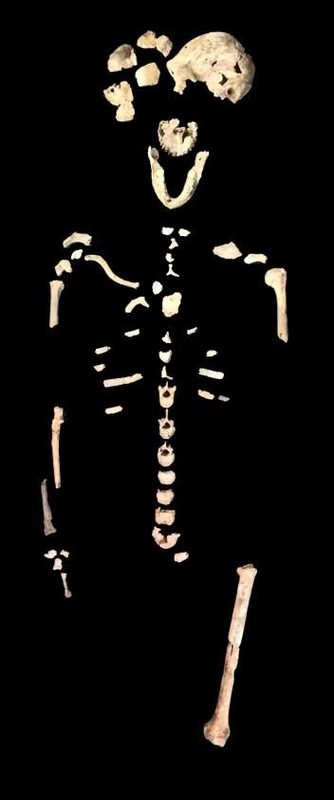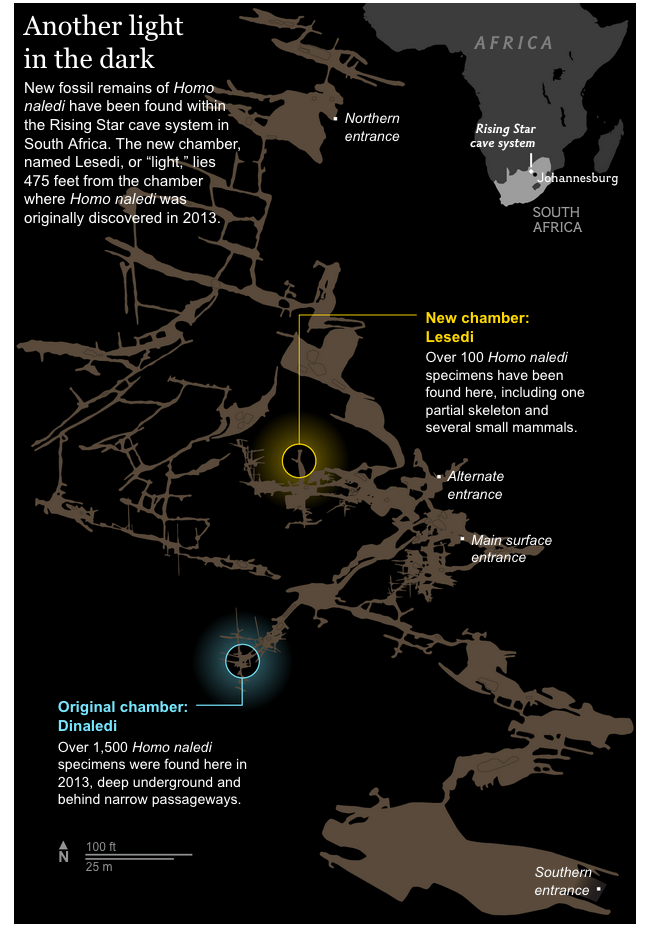
First discovered in 2013 by two cavers exploring the Rising Star cave system near Johannesburg, a stunning trove of hominin remains—the single richest fossil site of its kind ever found in Africa—revealed a tiny-brained species with shoulders and a torso like an ape's, but with some unshakably humanlike features as well. The mosaic's name: Homo naledi, after the Sesotho word for "star."
Now, the species's star shines that much brighter. In papers published Tuesday in eLife, the team—led by University of the Witwatersrand (Wits) paleoanthropologist Lee Berger—provides an age range for the remains first reported in 2015: between 236,000 and 335,000 years old. The team also describes a second chamber within Rising Star that contains yet-undated H. naledi remains.
If these dates hold, it could mean that while our own species was evolving from other, large-brained ancestors, a little-brained shadow lineage was lingering on from a much earlier period, perhaps two million years ago or more. The proposed age range for the fossils also overlaps with the early Middle Stone Age, fueling a provocative, though unproven, possibility: that the stone-tool record in South Africa from that time wasn't just the handiwork of anatomically modern humans.
"How do you know that these sites that are called [examples of] the rise of modern human behavior aren't being made by Homo naledi?" says Berger, who is also a National Geographic explorer-in-residence. "You can imagine how disruptive that could be."
A Puzzle's Missing Piece
When Homo naledi made its public debut in 2015, several key details about the species still lurked in the shadows. How was H. naledi related to other hominin species? Was it the "root Homo" at the base of our genus's lineage, as elements of its body plan might suggest?
And as National Geographic reported at the time, the initial announcement frustrated scientists because of what it was missing.

Some subsequent studies tried to fill the void by statistically estimating H. naledi's age, based on how its skull and teeth compared to other hominins'. One pegged the species at about two million years old, give or take; the other, a study by Simon Fraser University researcher Mana Dembo, suggested it was about 912,000 years old...plus or minus about a million years.
But all the while, Berger's team was nursing a hunch that H. naledi was younger. "It's been beautiful to watch, because as all these studies were being published, we essentially knew it was going to be less than half a million years old," says Paul Dirks, a geologist at Wits and James Cook University.
Dirks says the team held off from going public earlier with a date because if the initial data had been wrong, skeptics would have seized on the misfire as evidence of the team's recklessness—a criticism some already level at the team for its breakneck publishing pace. The chamber's unusual lack of any faunal remains also meant the dating would require performing destructive sampling on the invaluable fossils themselves.
So after the fossils were described, Dirks and 19 other scientists decided to throw the methodological kitchen sink at them, using six different dating methods to constrain H. naledi's age.
To start, they radiometrically dated some flowstones—layers of calcite laid down by running water—that had covered some of the H. naledi remains. Two labs independently showed that the flowstone was about 236,000 years old, meaning that the underlying H. naledi remains had to be older.
Getting a maximum age proved trickier; no flowstone sandwiched the fossils from below. The team arrived at an oldest age—335,000 years old—by putting sediment grains and three H. naledi teeth through a battery of dating methods, including some based on the radiation dosage the materials had received after basking in the cave's natural background radioactivity.

Jungers, now a research associate at Madagascar's Association Vahatra, says that the new dating once again emphasizes that fixing an age to fossils based on their shape poses risks. "Homo naledi (like Homo floresiensis) pounds another nail into that analytical coffin," he says by email. H. floresiensis, nicknamed "The Hobbit," was a diminutive, small-brained species that existed on the Indonesian island of Flores until as recently as 60,000-100,000 years ago.
Warren Sharp, a geochronologist at the University of California, Berkeley, who wasn't involved in the study, applauds the team for the thoroughness of their effort. However, he emphasizes that by necessity, the team's oldest age estimate requires modeling the cave's radioactivity and behavior through time—a brutally difficult task.
"They may have done about as good a job as you can do with those techniques... [but] the dates on the teeth are inherently less convincing," says Sharp. "I'm not saying that's the authors' fault. I'm just saying you have to live with that."
Another Light in the Dark
Berger and his colleagues also announced Tuesday that Rising Star has yielded a second chamber containing H. naledi fossils, discovered during fieldwork in November 2013 by Steven Tucker and Rick Hunter, the same cavers who had found the first trove in a chamber called Dinaledi.
The second chamber, named Lesedi—for the Setswana word for "light"—is more than 300 feet from the Dinaledi Chamber, which contained over 1,500 specimens of H. naledi.
About 130 additional specimens have been recovered from the Lesedi Chamber so far, representing two adults and at least one child. One of the two adult skeletons, likely a male, is remarkably complete, and includes a skull with many of its face bones preserved, filling in crucial information that was missing from the original find. Little wonder that the team named the individual Neo, after the Sesotho word for "gift."
"[Neo] is really comparable in preservation to the Lucy skeleton," says Hawks, referring to the famously complete 3.2 million-year-old skeleton of Australopithecus afarensis from Ethiopia. "We're missing some parts that Lucy has; we have some parts that Lucy doesn't have."
Much like the Dinaledi Chamber, which requires passing through a seven-inch-wide slot to enter, the Lesedi Chamber also poses unique challenges to archaeological excavations. Marina Elliott, the Wits exploration scientist who led excavations in both chambers, says that while Lesedi isn't quite as hard to reach as Dinaledi, it's harder to excavate. Neo was found in a narrow "blind" alcove less than two feet wide.
"I basically excavate lying on my chest or in the fetal position, with both my shoulders pinned in by rock on either side," she says. "It's extremely physically difficult; I've tried to do a lot of yoga to get myself to be able to do it."
Berger himself hasn't set foot in Dinaledi, and only once has he ventured into Lesedi. During his return to the surface, he got stuck for nearly an hour, requiring his colleagues to pull him out by ropes around his wrists. Team members now call the squeeze the Berger Box.
A Body of Evidence
In light of the Lesedi Chamber's discovery, Berger's team has claimed some vindication for one of its most hotly contested hypotheses: that in some form or fashion, H. naledi used the Rising Star cave system as a place to dispose of its dead.
That audacious theory arose out of the Dinaledi Chamber's sheer weirdness, which the Lesedi Chamber shares. The chambers contain almost exclusively H. naledi remains, which is highly unusual (though Lesedi does contain some faunal remains). What's more, Berger and his colleagues haven't yet found any alternate entrances into the chambers.
"What are the chances that you have some natural phenomenon that has left accumulations of multiple bodies, adults and juveniles, in two far-separated parts of the cave, in very similar depositional circumstances—and we found both of them?" says Hawks. "It's very difficult to believe that this is some kind of coincidence."
Many scholars demand more evidence before they even entertain the claim. "Many experts (including me) consider such complex behavior unlikely for a creature with a brain size close to that of a gorilla, particularly when a requirement for the controlled use of fire (for lighting) probably has to be added in," says Chris Stringer, an anthropologist at the Natural History Museum in London who reviewed the newly published papers.
What's more, outside archaeologists and team members alike caution that if H. naledi really were disposing of its dead, it wouldn't necessarily be driven by humanlike ritual or reason.
"There is something really strange happening, that's for sure," says Wits postdoctoral fellow Aurore Val, who criticized the body-disposal hypothesis in a 2016 essay. "You have to be careful about mortuary practices... they are not digging a hole, there are no tools. This is not a ritual per se, like what you see with Homo sapiens and Neanderthals."
"We think of humans as being very clever, and having reasons for things," says Hawks. "I'm not thinking of reason—the simple thing you can do is make sure that bodies are not scavenged by predators or subject to the elements."
A Time and Place
Berger and his team haven't dated the Lesedi remains, and the dates they have from Dinaledi don't capture H. naledi's longevity as a species. But the brief snapshot the dates offer capture the beginning of the Middle Stone Age, a time when the genus Homo was still a diverse, tangled bush—not the pruned, single-species lineage we see today.
Around 230,000 to 330,000 years ago, there weren't just precursors to anatomically modern humans on the landscape: There would have been Neanderthals in Europe and Asia, Denisovans in Asia, potentially some Eurasian pockets of our ancestors Homo erectus, as well as the forerunners of H. floresiensis. Amid this pantheon, H. naledi would be the first known that lived in Africa at that time, other than some scattered evidence of archaic forms of H. sapiens.
It's still unclear, though, how H. naledi fits onto humankind's tree. Most researchers agree that the immediate ancestor of Homo sapiens was H. erectus, which first appeared 1.8 million years ago. But one analysis performed by Berger and his colleagues suggests that, in spite of the more recent age for the known H. naledi remains, its morphology suggests that it could in fact be a better candidate for our most recent ancestor, surviving millions of years in tandem after giving rise to the branch leading to modern humans.
Other scientists believe it more likely that the Rising Star remains represent an offshoot lineage that survived in a continental cul-de-sac, much like H. floresiensis did on its island refuge.
"It may not turn out to be on the direct line to humans," says William Kimbel, director of the Institute of Human Origins at Arizona State University. "But that doesn't mean it's unimportant. It's fascinating."
And since the fossil record in sub-Saharan Africa is still so sparse, chances are good that H. naledi wasn't alone.
"We shouldn't be shocked that there were other evolutionary experiments in the Pleistocene that may or may not have contributed to the emergence of Homo sapiens," Jungers says by email. "Homo naledi suggests that Africa probably harbors other paleoanthropological surprises."
Berger's team also argues that if H. naledi and modern humans lived alongside one another, the stone tools littering South Africa from that time period might not have been the work of humans. "We've assumed that this [toolmaking] is a sign of modern human complexity, but the fact is that this is an area of the world where naledi is the best documented hominin," says Hawks.
"People will jump out and assume [the toolmakers] were modern humans," adds Berger. "But if you're going to play by scientific rules, someone like me might lean back in a soft, comfy chair smoking a pipe and go, 'Oh? Prove it.'"
Mustering similar moxie, the Rising Star team also argues that H. naledi could point to subequatorial Africa as the primary driver of early hominin diversity. This strikes a contrast to the claim that East Africa incubated humankind's early evolution, a narrative that rests on rich hominin fossil sites in Ethiopia, Kenya, and Tanzania.
Berger acknowledges that his argument will prove controversial. But he bristles at the suggestion that H. naledi represents an intriguing sideshow of evolution, while East Africa hosted the main event. "That's not the way we should read maps, it's not the way evolution happens, nor was that the goal of hominin expansion," he says.
Bernard Wood, a paleoanthropologist at George Washington University, notes that either way, the debate over where Homo originated might be getting unnecessarily heated.
"We must make sure that we don't fall into the trap of assuming that all of the important events in hominin evolution occurred where we have the good fortune to find fossils," says Wood. "It makes little sense to overturn one misguided Garden of Eden hypothesis with another equally misguided Garden of Eden hypothesis. We should all relax, take a deep breath [and] celebrate the fact that this is interesting evidence."
By the looks of it, Rising Star will drive further celebration in the years to come. Hawks estimates that less than five percent of the Dinaledi Chamber has been excavated so far, and Lesedi likely contains other remains. The team is also busy prospecting other cave systems nearby, in search of other evidence of our ancient cousins.
"It also should encourage people not to give up hope about exploration," says Elliott. "Exploration's not dead."




Reader Comments